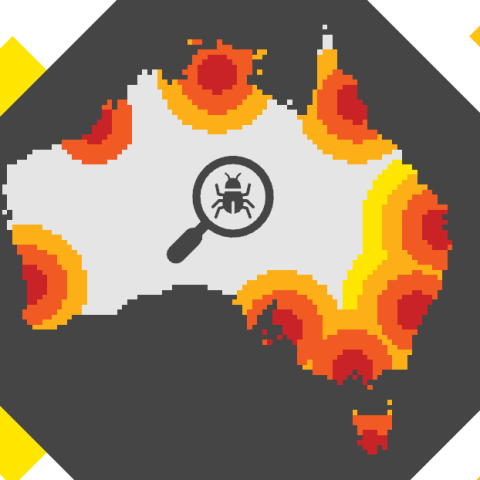Biosecurity Commons recently spoke to Dr James Camac, a Chief Investigator in CEBRA at the University of Melbourne who developed the Risk Mapping methodology, about our platform and the challenges faced by the biosecurity research community.
Tell us about your background and how you moved into biosecurity?
I started my career as a plant field ecologist where I worked in the Victorian alps monitoring a variety of long-term monitoring and experimental sites. This work led me to undertake a PhD at the University of Melbourne, where I focused on using field experiments, natural experiments, and long-term monitoring to develop statistical models that could be used to examine and forecast changes in alpine vegetation under changing climate and fire regimes.
Following my PhD, I continued to develop my quantitative skills by undertaking a postdoctoral fellowship at Macquarie University. Here, I worked with world-leading plant ecologists and Data61 machine learners to develop a multi-species model of tropical tree mortality. During this fellowship I also gained a greater appreciation for the importance of functional programming and the importance of developing reproducible data analytical workflows.
After completing this fellowship, I accepted a position at the Centre of Excellence for Biosecurity Risk Analysis (CEBRA). In this role I have worked closely with DAFF and MPI on a variety of key research projects including:
• Evaluating the effectiveness of Australia’s biosecurity system;
• Developing establishment likelihood maps (i.e., risk maps) for a range of National Priority Plant Pests;
• Developing spatial surveillance models to quantify likelihoods of threat absence; and
• Developing a global model pest exposure model as a function of international trade and changing climate.
In addition to those projects, I am also the lead lecturer for the postgraduate subject Biosecurity: Managing Invasive Species – a subject that exposes students to both the science and policy of invasive species management, but also the challenges faced by governments and industry in implementing effective and efficient management strategies.
In 2021 I became a Chief Investigator in CEBRA.
What do you think are the biggest challenges that biosecurity research is currently facing?
In my view, there are three significant challenges faced by biosecurity researchers and practitioners.
The first is how to best harness existing data to aid biosecurity regulators and industry in making scientifically informed decisions. This can be incredibly challenging because: 1) many decisions require data that is often stored in a range of disparate databases (e.g., international, national, sub-national databases); and 2) the state-of-the-art tools used to synthesise and model data for informing decisions is often done by academics for academics, and thus, not easily implemented in real-world situations due to data constraints and technical skills and resources required. Too often scientific methods are published that might be useful in niche cases, but which are unable to be scaled up to the level required to inform broader biosecurity policy and management. As a result, there is a real need to focus on methods that both integrate disparate datasets more easily and simplify processes for using data to inform decisions – this will require close collaboration with end-users (policy makers and industry).
The second challenge is a critical need to understand and forecast how changing climate will impact international trade and human movement – the two predominate means of exotic species introductions. Evidence is clear that changing climate will have significant impacts on species distributions (i.e., expanding in some regions, and contracting in others). It will also impact international trade flows and human movement, the combined effect resulting in a changed exposure to different biosecurity threats. Understanding how risk may change in the future is essential to move biosecurity from a reactionary system to one which is capable of proactive at managing risk.
The third major challenge faced by biosecurity practitioners is to determine where the biggest “bang for buck” can be obtained across a wide range of pre-border, border, and post-border risk mitigation strategies as well as a multitude of threats. All biosecurity systems are constrained by a fixed budget, and thus, it is critical to determine which threats and which risk-reducing activities provide the greatest return on investment — in terms of damages avoided to agricultural, environmental, or social assets. This is challenging because of the difficulties of comparing non-market damage caused to the community and to environmental assets with market-based agricultural damages. Decisions are made even more complicated by the need to incorporate human behaviour in the design of activities, policies, and regulations – but this is a ‘must-do’ if we want to guarantee expenditure decisions will maximise bang for buck.
All three challenges are heavily dependent on data and the use of sophisticated, but practical, models and tools for timely decision-making. It also requires a strong focus on multidisciplinary decision-making that incorporates science, economics, human behaviour.
How do you think Biosecurity Commons will benefit Australia?
Biosecurity Commons will directly enhance Australia’s biosecurity system by improving the accessibility to necessary data and modelling frameworks required for both industry and government to make scientifically robust policy and management decisions. Biosecurity Commons will act as a central repository for a wide range of disparate datasets on climate, land-use and other spatial attributes required to inform biosecurity policy and management. Moreover, through it’s easy to use interface, it removes the significant technical hurdle faced by governments and industry in using state-of-the-art tools and models to inform decision-making.
I’m particularly impressed that Biosecurity Commons has taken existing state-of-the-art tools and developed user-friendly, and inter-dependent workflows for several fundamental challenges faced by biosecurity practitioners, including methods for determining:
1) A threat’s potential climatic distribution using a wide range of Species Distribution Modelling (SDM) methods.
2) Threat establishment potential as a function of pathway-specific propagule pressure and the suitability of the biotic and abiotic environment
3) Likelihoods of absence as a function of surveillance effort, sensitivity, and pest risk maps; and
4) A threat’s spread across landscapes; and
5) Where to allocate finite resources to maximise benefit.
The workflows and tools built into Biosecurity Commons helps address several of the fundamental challenges faced by biosecurity practitioners and researchers – including the three I address above. I strongly believe that Biosecurity Commons will usher in a new era of scientifically robust biosecurity policy and management and will be an instrumental tool in training regional partners and the next generation of biosecurity practitioners.




